HYUNDAI SONATA HYBRID 2019 User Guide
Manufacturer: HYUNDAI, Model Year: 2019, Model line: SONATA HYBRID, Model: HYUNDAI SONATA HYBRID 2019Pages: 546, PDF Size: 78.75 MB
Page 11 of 546
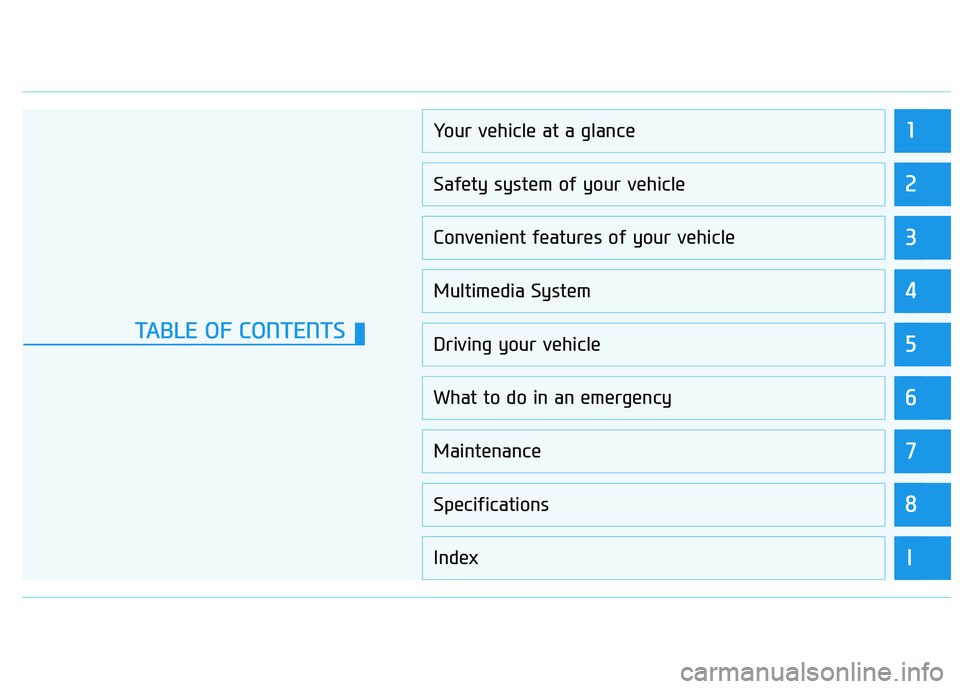
1
2
3
4
5
6
7
8
I
Your vehicle at a glance
Safety system of your vehicle
Convenient features of your vehicle
Multimedia System
Driving your vehicle
What to do in an emergency
Maintenance
Specifications
Index
TABLE OF CONTENTS
Page 12 of 546
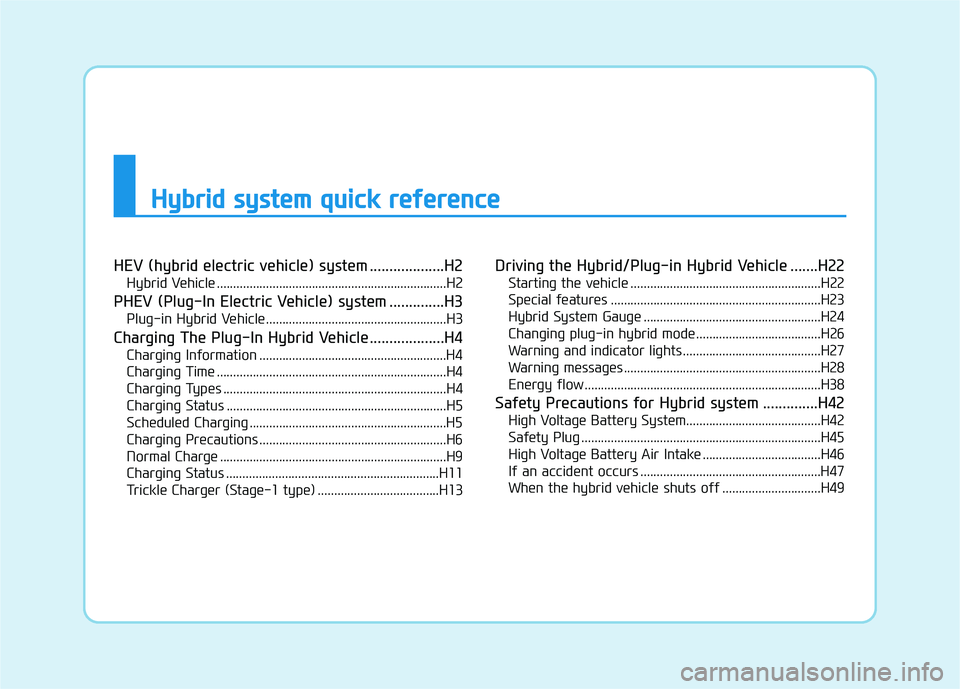
HHyybbrriidd ss yy ssttee mm qq uu iicc kk rr ee ffee rree nn ccee
HEV (hybrid electric vehicle) system ...................H2
Hybrid Vehicle ......................................................................H2
PHEV (Plug-In Electric Vehicle) system ..............H3 Plug-in Hybrid Vehicle.......................................................H3
Charging The Plug-In Hybrid Vehicle ...................H4 Charging Information .........................................................H4
Charging Time ......................................................................H4
Charging Types ....................................................................H4
Charging Status ...................................................................H5
Scheduled Charging ............................................................H5
Charging Precautions .........................................................H6
Normal Charge .....................................................................H9
Charging Status .................................................................H11
Trickle Charger (Stage-1 type) .....................................H13 Driving the Hybrid/Plug-in Hybrid Vehicle .......H22
Starting the vehicle ..........................................................H22
Special features ................................................................H23
Hybrid System Gauge ......................................................H24
Changing plug-in hybrid mode ......................................H26
Warning and indicator lights ..........................................H27
Warning messages ............................................................H28
Energy flow ........................................................................H38
Safety Precautions for Hybrid system ..............H42 High Voltage Battery System.........................................H42
Safety Plug .........................................................................H45
High Voltage Battery Air Intake ....................................H46
If an accident occurs .......................................................H47
When the hybrid vehicle shuts off ..............................H49
Page 13 of 546
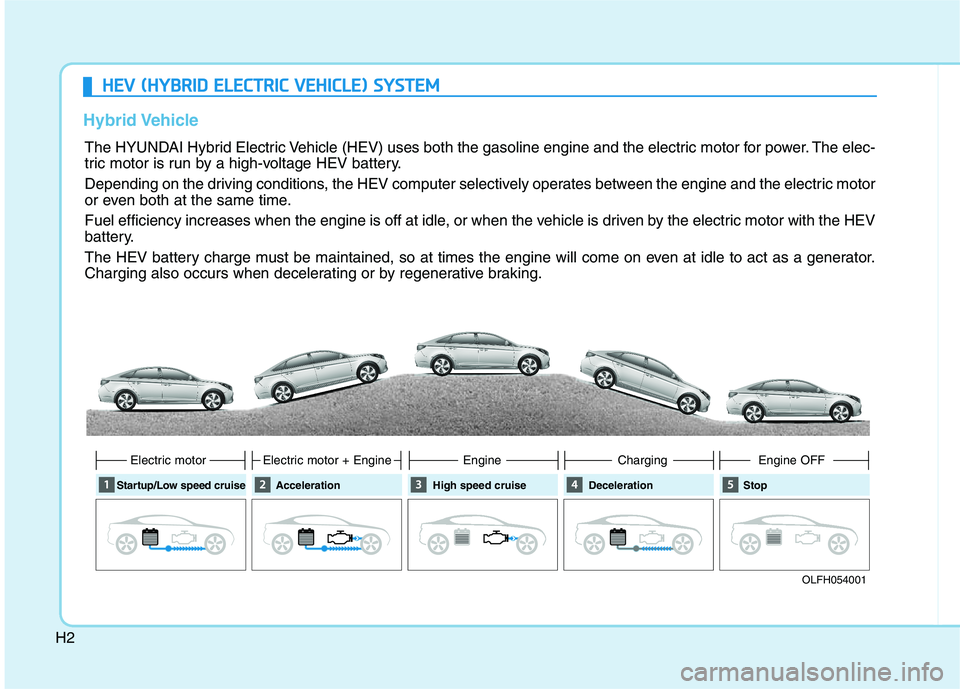
H2
Hybrid Vehicle
HHEEVV (( HH YY BBRRIIDD EE LLEE CCTT RR IICC VV EEHH IICC LLEE )) SS YY SSTT EEMM
The HYUNDAI Hybrid Electric Vehicle (HEV) uses both the gasoline engine and the electric motor for power. The elec-
tric motor is run by a high-voltage HEV battery.
Depending on the driving conditions, the HEV computer selectively operates between the engine and the electric motor
or even both at the same time.
Fuel efficiency increases when the engine is off at idle, or when the vehicle is driven by the electric motor with the HEV
battery.
The HEV battery charge must be maintained, so at times the engine will come on even at idle to act as a generator.
Charging also occurs when decelerating or by regenerative braking.
OLFH054001
Startup/Low speed cruise
Electric motor
AccelerationElectric motor + Engine High speed cruiseEngineDecelerationCharging Stop Engine OFF
Page 14 of 546
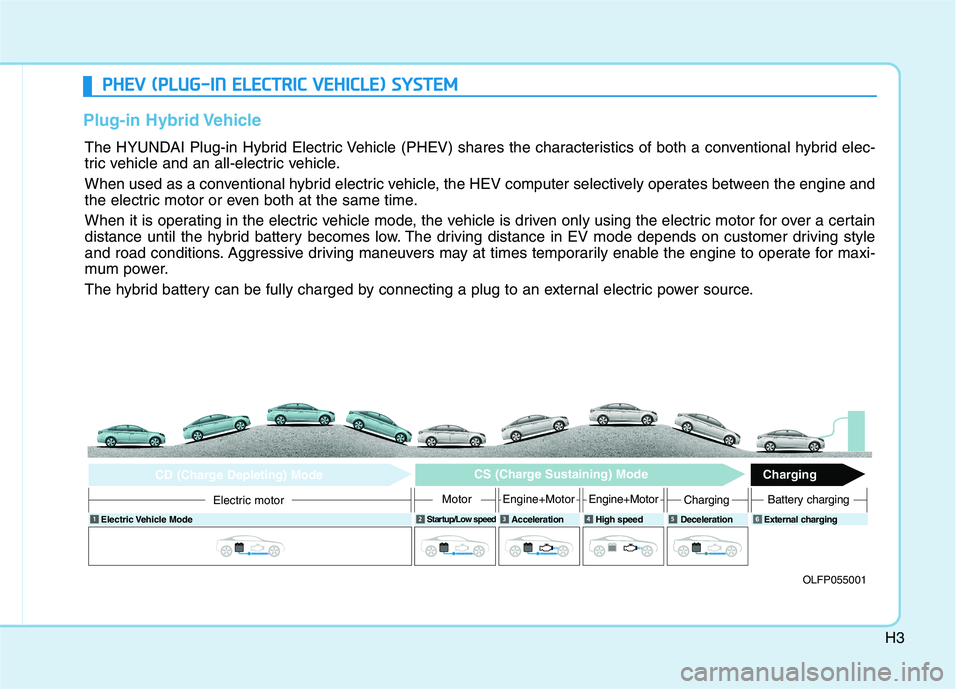
H3
PPHH EEVV (( PP LLUU GG--IINN EE LLEE CCTT RR IICC VV EEHH IICC LLEE )) SS YY SSTT EEMM
Plug-in Hybrid Vehicle
The HYUNDAI Plug-in Hybrid Electric Vehicle (PHEV) shares the characteristics of both a conventional hybrid elec-
tric vehicle and an all-electric vehicle.
When used as a conventional hybrid electric vehicle, the HEV computer selectively operates between the engine and
the electric motor or even both at the same time.
When it is operating in the electric vehicle mode, the vehicle is driven only using the electric motor for over a certain
distance until the hybrid battery becomes low. The driving distance in EV mode depends on customer driving style
and road conditions. Aggressive driving maneuvers may at times temporarily enable the engine to operate for maxi-
mum power.
The hybrid battery can be fully charged by connecting a plug to an external electric power source.
OLFP055001
Electric Vehicle Mode
Startup/Low speed
Acceleration High speed Deceleration External charging
Electric motor
CD (Charge Depleting) Mode CS (Charge Sustaining) Mode
Charging
MotorEngine+MotorEngine+MotorChargingBattery charging
6
Page 15 of 546
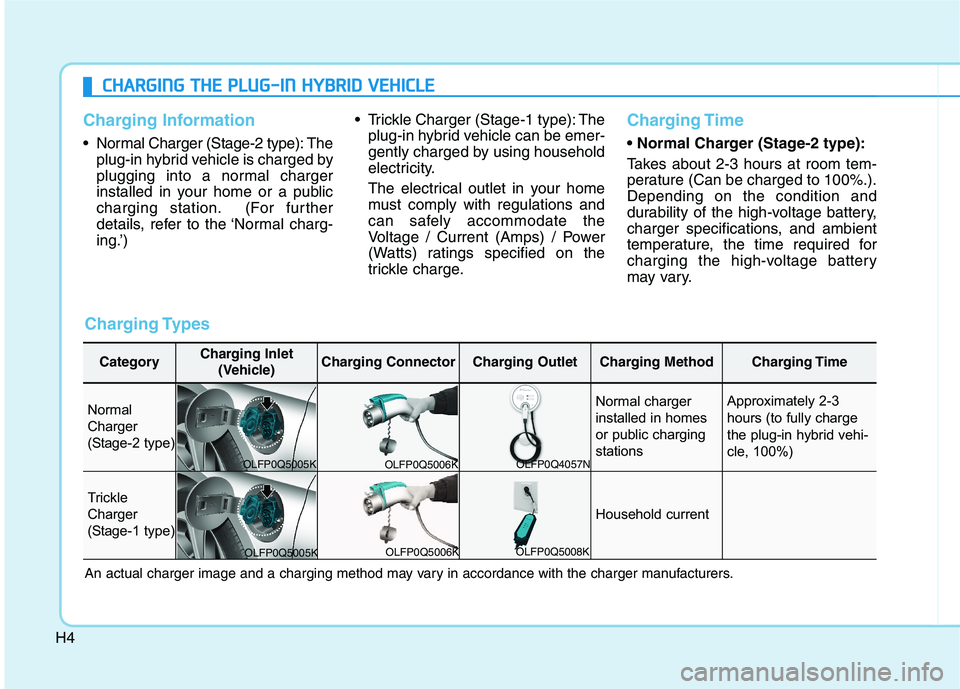
H4
CCHH AARRGG IINN GG TT HH EE PP LLUU GG--IINN HH YY BBRRIIDD VV EEHH IICC LLEE
Charging Information
• Normal Charger (Stage-2 type): The
plug-in hybrid vehicle is charged by
plugging into a normal charger
installed in your home or a public
charging station. (For further
details, refer to the ‘Normal charg-
ing.’) Trickle Charger (Stage-1 type): The
plug-in hybrid vehicle can be emer-
gently charged by using household
electricity.
The electrical outlet in your home
must comply with regulations and
can safely accommodate the
Voltage / Current (Amps) / Power
(Watts) ratings specified on the
trickle charge.
Charging Time
• Normal Charger (Stage-2 type):
Takes about 2-3 hours at room tem-
perature (Can be charged to 100%.).Depending on the condition and
durability of the high-voltage battery,
charger specifications, and ambient
temperature, the time required for
charging the high-voltage battery
may vary.
Charging Types
CategoryCharging Inlet
(Vehicle)Charging ConnectorCharging OutletCharging Method Charging Time
Normal
Charger
(Stage-2 type)Normal charger
installed in homes
or public charging
stations Approximately 2-3
hours (to fully charge
the plug-in hybrid vehi-
cle, 100%)
Trickle
Charger
(Stage-1 type)
Household current
An actual charger image and a charging method may vary in accordance with the charger manufacturers. OLFP0Q5005K
OLFP0Q5006K
OLFP0Q5006K OLFP0Q5008KOLFP0Q4057N
OLFP0Q5005K
Page 16 of 546
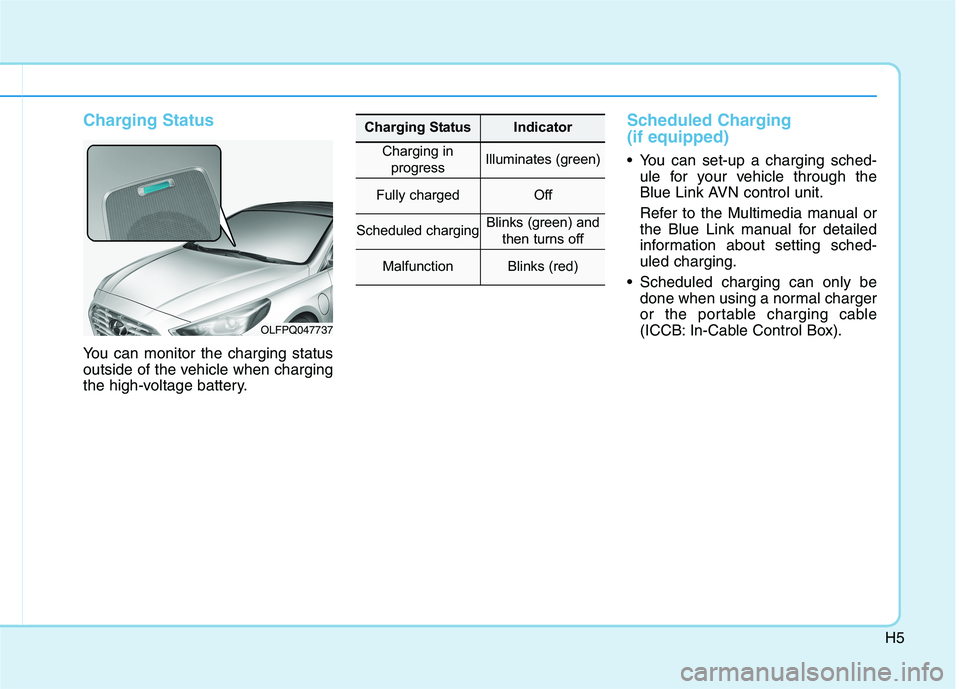
H5
Charging Status
You can monitor the charging status
outside of the vehicle when charging
the high-voltage battery.
Scheduled Charging (if equipped)
You can set-up a charging sched-ule for your vehicle through the
Blue Link AVN control unit.
Refer to the Multimedia manual or
the Blue Link manual for detailed
information about setting sched-uled charging.
Scheduled charging can only be done when using a normal charger
or the portable charging cable
(ICCB: In-Cable Control Box).
OLFPQ047737
Charging StatusIndicator
Charging in
progressIlluminates (green)
Fully chargedOff
Scheduled chargingBlinks (green) and then turns off
MalfunctionBlinks (red)
Page 17 of 546
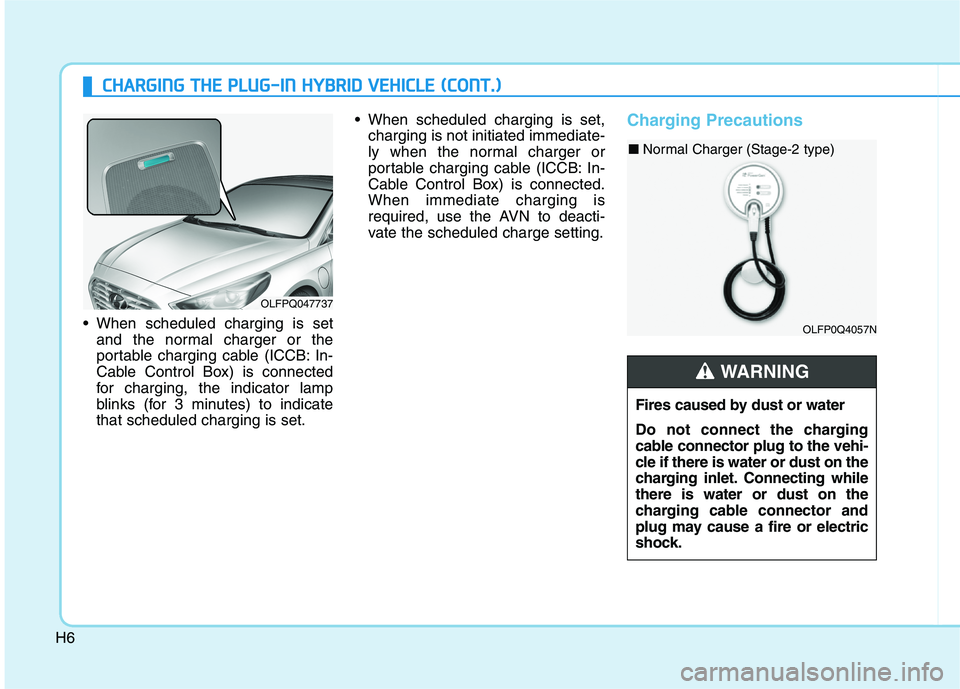
H6
CCHH AARRGG IINN GG TT HH EE PP LLUU GG--IINN HH YY BBRRIIDD VV EEHH IICC LLEE (( CC OO NNTT..))
When scheduled charging is set
and the normal charger or the
portable charging cable (ICCB: In-
Cable Control Box) is connected
for charging, the indicator lamp
blinks (for 3 minutes) to indicatethat scheduled charging is set. When scheduled charging is set,
charging is not initiated immediate-
ly when the normal charger or
portable charging cable (ICCB: In-
Cable Control Box) is connected.When immediate charging is
required, use the AVN to deacti-
vate the scheduled charge setting.
Charging Precautions
OLFP0Q4057N
■
Normal Charger (Stage-2 type)
Fires caused by dust or water
Do not connect the charging
cable connector plug to the vehi-
cle if there is water or dust on the
charging inlet. Connecting whilethere is water or dust on the
charging cable connector and
plug may cause a fire or electric
shock.
WARNING
OLFPQ047737
Page 18 of 546
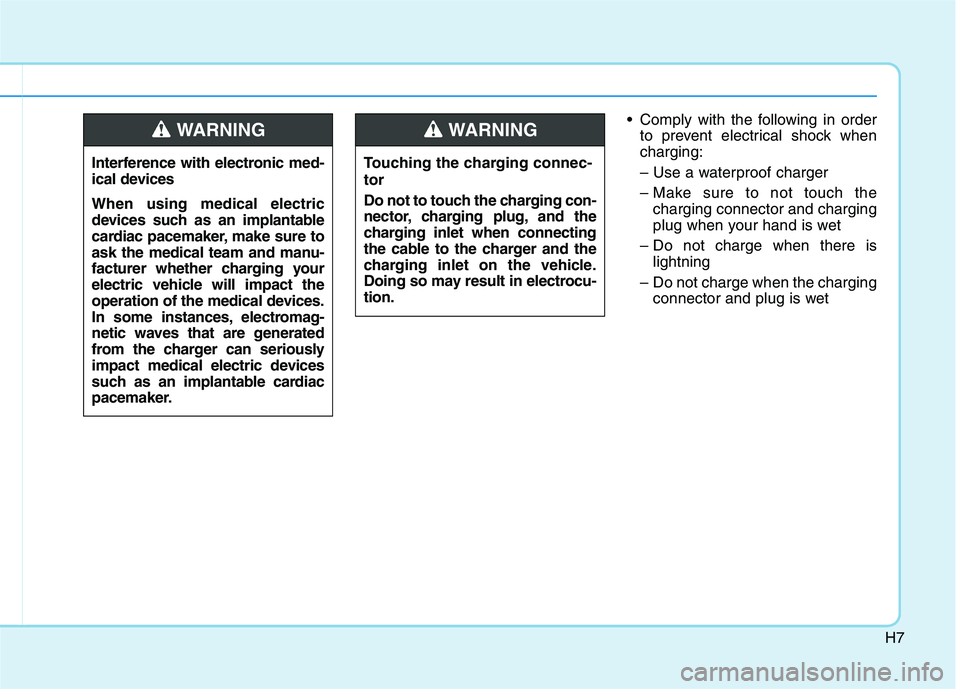
H7
Comply with the following in orderto prevent electrical shock when charging:
– Use a waterproof charger
– Make sure to not touch thecharging connector and charging
plug when your hand is wet
– Do not charge when there is lightning
– Do not charge when the charging connector and plug is wet
Touching the charging connec- tor
Do not to touch the charging con-
nector, charging plug, and the
charging inlet when connecting
the cable to the charger and the
charging inlet on the vehicle.
Doing so may result in electrocu-tion.WARNING
Interference with electronic med-
ical devices When using medical electric
devices such as an implantable
cardiac pacemaker, make sure to
ask the medical team and manu-
facturer whether charging your
electric vehicle will impact the
operation of the medical devices.
In some instances, electromag-
netic waves that are generated
from the charger can seriously
impact medical electric devices
such as an implantable cardiac
pacemaker.
WARNING
Page 19 of 546
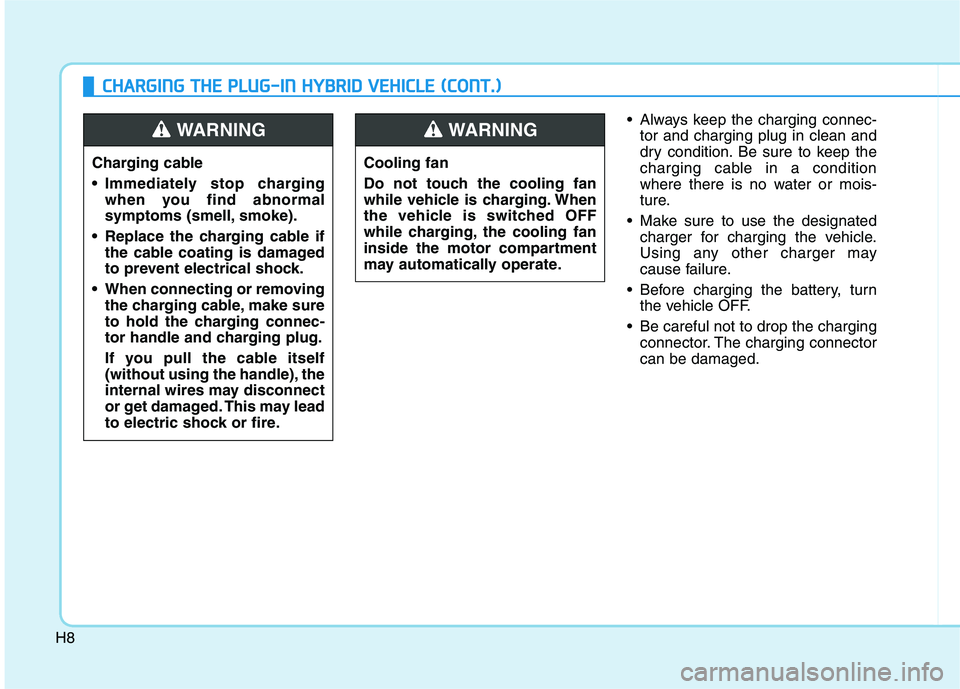
H8
CCHH AARRGG IINN GG TT HH EE PP LLUU GG--IINN HH YY BBRRIIDD VV EEHH IICC LLEE (( CC OO NNTT..))
Always keep the charging connec-
tor and charging plug in clean and
dry condition. Be sure to keep the
charging cable in a condition
where there is no water or mois-
ture.
Make sure to use the designated charger for charging the vehicle.
Using any other charger may
cause failure.
Before charging the battery, turn the vehicle OFF.
Be careful not to drop the charging connector. The charging connectorcan be damaged.
Cooling fan
Do not touch the cooling fan
while vehicle is charging. When
the vehicle is switched OFF
while charging, the cooling fan
inside the motor compartment
may automatically operate.WARNING
Charging cable
Immediately stop charging
when you find abnormal
symptoms (smell, smoke).
Replace the charging cable if the cable coating is damaged
to prevent electrical shock.
When connecting or removing the charging cable, make sure
to hold the charging connec-
tor handle and charging plug.
If you pull the cable itself
(without using the handle), the
internal wires may disconnect
or get damaged. This may lead
to electric shock or fire.
WARNING
Page 20 of 546
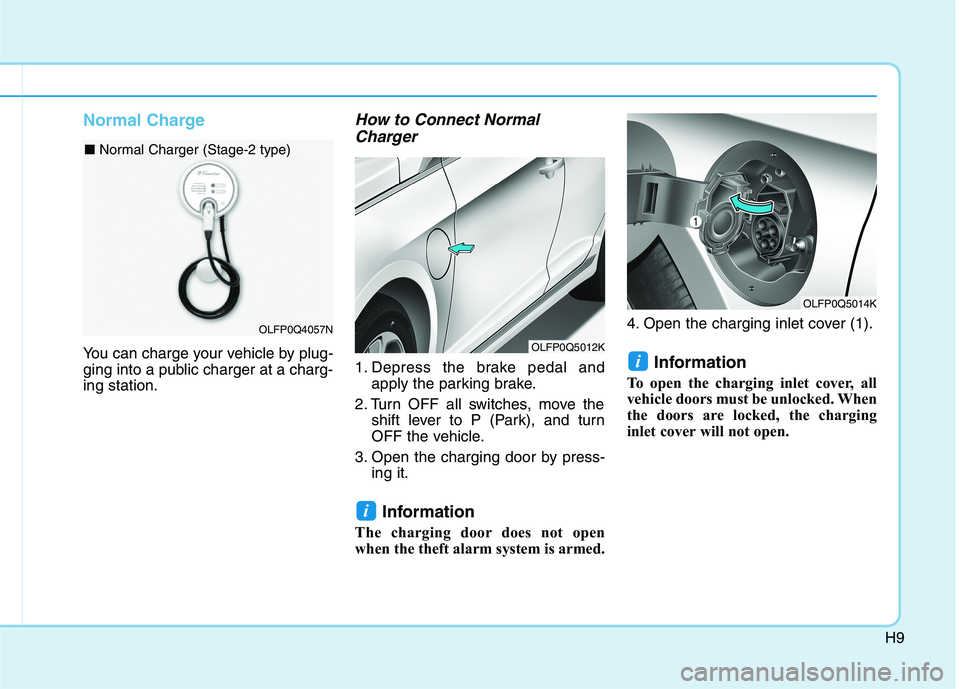
H9
Normal Charge
You can charge your vehicle by plug-
ging into a public charger at a charg-ing station.
How to Connect NormalCharger
1. Depress the brake pedal and apply the parking brake.
2. Turn OFF all switches, move the shift lever to P (Park), and turn
OFF the vehicle.
3. Open the charging door by press- ing it.
Information
The charging door does not open
when the theft alarm system is armed. 4. Open the charging inlet cover (1).
Information
To open the charging inlet cover, all
vehicle doors must be unlocked. When
the doors are locked, the charging
inlet cover will not open. i
i
OLFP0Q4057N
■
Normal Charger (Stage-2 type)
OLFP0Q5012K
OLFP0Q5014K